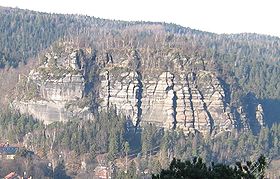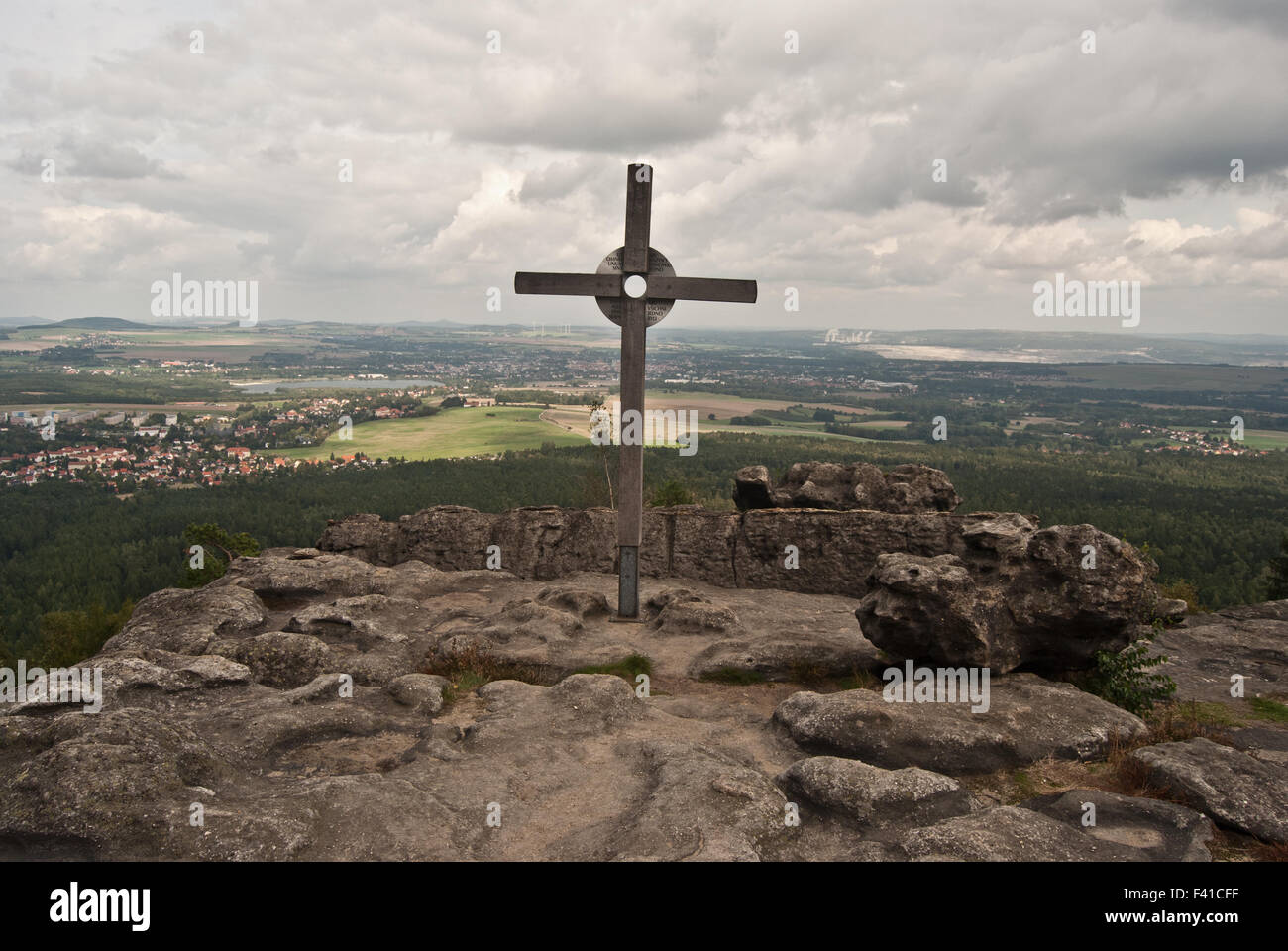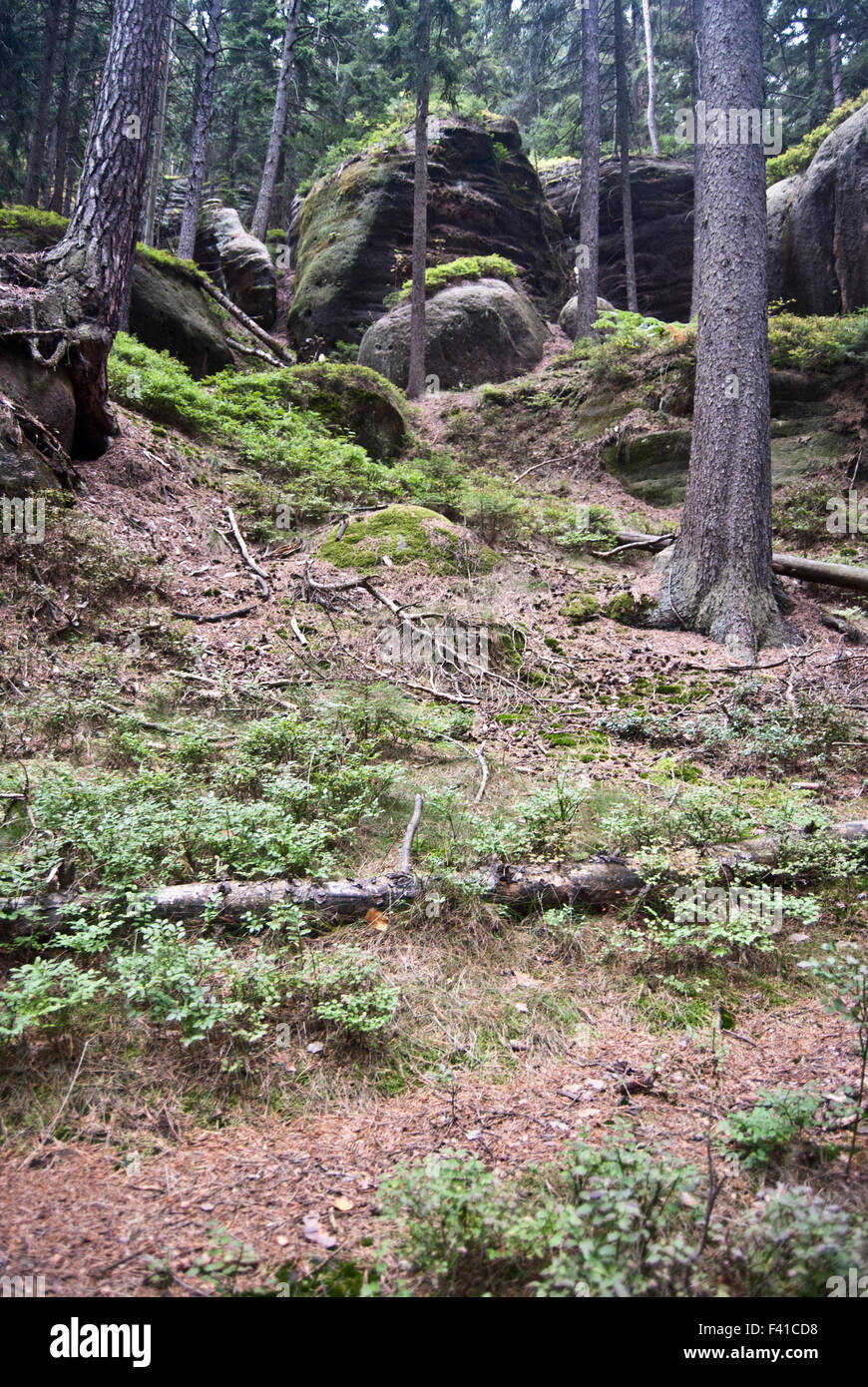Oybin (hill)
Oybin
The Oybin is a 514 meter high mountain of the Zittau mountains above the small town in the southeast of Saxony. On it are the ruins of the castle Oybin who had converted to his retirement home Emperor Charles IV, and a monastery of Celestine, which was founded in 1369.
The castle hill fort occupies the entire summit of the mountain Oybin. It includes not only the actual castle on the west side with the imperial house and the monastery ruins, the mountain cemetery of the church and a castle Oybin restaurant. At the highest point of the mountain is a camera obscura. The located on the slope mountain church Oybin has featured paintings in its interior.
Settlement and castle history
Ancient times to the (1300)
The first archaeologically detectable Bronze Age settlement on the mountain Oybin dates from the 11th and 12th century BC A settlement in the Slavic period could be demonstrated using fewer individual pieces. Earliest construction meshing originate from the 13th century. In this century, the first recorded destruction through the town of Zittau falls in 1291st The castle was used as a base for raids by marauding knights. This is also the first mention of Oybin ( Moybin ). Soon the castle was rebuilt.
Medieval and Wedding (1300-1577)
In the years 1311 to 1316, the plant was expanded to a fortified castle section to protect the nearby trade routes under Henry of Lipa, his character Marshal of King John of Luxembourg. Already in 1346 it fell back directly to the Bohemian crown. In 1364 Emperor Charles IV built on the Oybin the imperial house, which he wanted to use as his retirement home. He also started in 1366 with the construction of the Gothic church ( with the participation of famous Prague Dombauhütte Parler ), which was completed already in 1384. 1369 donated the Emperor the Order of the Celestine monastery on the Oybin. Important member of that Convention was the Inquisitor and Prior ( from 1395 ) Peter Zwicker.
During the Hussite Wars of Oybin was attacked twice. In 1420, under Zbynec Buchowec and Chwal Repicky of macho joke (Czech: Chval Repicky z Machovic ). Especially the strong walls and steep cliffs, it was thanks to them that the besiegers had to withdraw inconclusive. The Grange at the foot of the mountain was burned. Again, the Hussites appeared in 1429 before the castle monastery. There were troops of Procopius have the Great, their attack is taken four hours. Again, the defense proved to be stronger than the will of the Hussites stormy attack. The Oybin since was considered impregnable.
Part of the Prague Cathedral Treasury of St. Vitus Cathedral was to save him from the grasp of the Hussites, held on the Oybin. A chariot ( upgraded wagon ) was later found during excavations at the foot of Oybin. The castle was up in the second half of the 16th century continued to expand. During the Reformation, the monastery was dissolved and a gradual decline. 1577 lightning struck into the church, which burned down. Further destruction followed in 1681 by a rockslide. At this time the castle was already uninhabited and was used by the valley inhabitants as a quarry.
Modern Times ( from 1800)
A "rediscovery" of the castle was during the Romantic period, when the Saxon court painter Johann Alexander Thiele discovered the romantic, overgrown ruins of nature as a motive. So then painted Caspar David Friedrich, Carl Gustav Carus and other painters of the Romantic ruin and made it known. Subsequently, the castle from 1829 was freed from the rubble and 1877 the imperial house renovation, to preserve it from further deterioration. Since the middle of the 19th century, more and more hikers and spa guests came to the mountain. This was ultimately to the establishment of a Eilpostkutschverbindung of Zittau in 1830 and the opening of the narrow-gauge railway from Zittau to Oybin in 1890. In 1883, the first time a museum on the mountain by Alfred Moschkau was opened. Beginning of the 20th century, the castle of Cornelius Gurlitt and Hugo Rathgens was recorded and analyzed scientifically. In 1936, there was a setback, the rich museum collection was decimated by sales of the heirs of Alfred Moschkau. Another setback came at the end of World War II, were looted as larger parts of the museum. Herrmann Knobloch saved the embedded there and almost destroyed Lenten Veil of 1472. During the next decades, a race began to decay. Further restoration work followed. Thus, the ruined monastery, also because of the excellent acoustics, used from 1972 as a concert space ( including for the traditional Mönchszug ). Since 1991, the castle was extensively renovated and exposed large parts and reconstructed. Today visit up to 100,000 visitors a year, the castle and monastery ruins on the mountain Oybin. There are special guided tours and performed a historic castle and monastery festival annually.
Way to the summit
The climb to the plateau of the mountain starts in the center of Oybin and leads to the well-known mountain church up and ride takes about 15 minutes. A variant performs the "Knights Gorge ", a narrow rocky inlet. Alternatively, it is also possible to reach the semi- hourly free " Oybiner Mountain Express", a road-based tourist train to the entrance of the castle and monastery.
For the interior of the monastery an entry fee must be paid. To cover the entire summit plateau leads a circular route.
Representation of mountain and ruins in literature and art
The Berg combines a jump Sage ( " Jungfernsprung on the Oybin "), which was recorded among others by the Brothers Grimm and Ludwig Bechstein. The picturesque ruins on the Oybin with the cemetery of the village located there Oybin were a popular motif of many Romantic painters such as Caspar David Friedrich, Carl Gustav Carus, Ernst Ferdinand Oehme, Carl Blechen and Adrian Ludwig Richter. But you are not at the beginning of this tradition; already in the 18th century Oybin was presented by renowned artists such as Johann Alexander Thiele, Adrian Zingg and Johann Philipp Veith often.
Caspar David Friedrich: The Dreamer ( monastery Oybin ), 1835
Caspar David Friedrich: Oybin by moonlight, 1810
Monk trains
The historical monk trains on the Oybin are some of the few who maintain and preserve the historical remembrance of Celestine. Since 2008, the association is Historic Mönchszug Oybin eV official member of the Centro Celestiniano in L' Aquila, Italy.
Quote
From Zittau 's Blue Mountains, From the bells rock Oybin, Mag with the clouds flight Towards zieh'n A salute to you. Alfred Moschkau










